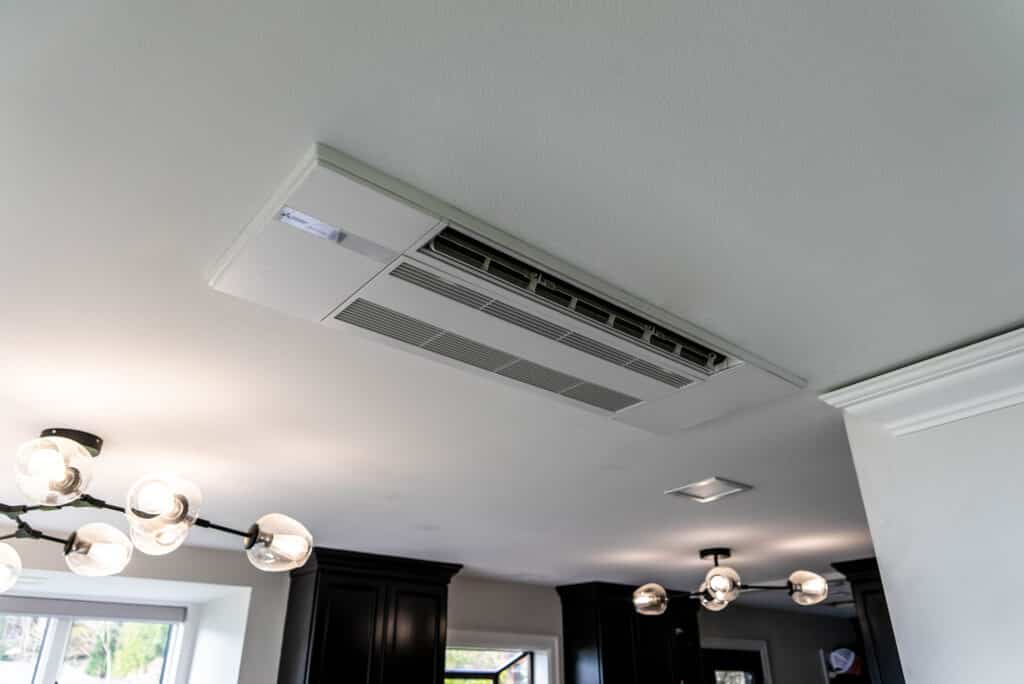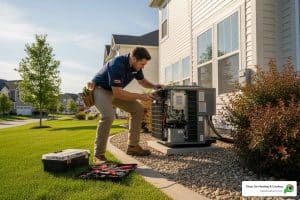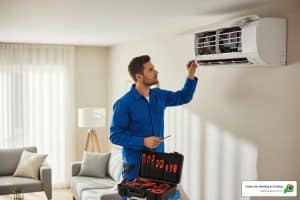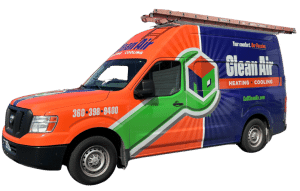Improve indoor air quality by addressing these key areas:
- Source Control: Identify and eliminate pollution sources like tobacco smoke, mold, and household chemicals.
- Ventilation: Increase airflow using fans, open windows, and kitchen hoods to reduce pollution levels.
- Air Cleaners: Use air purifiers with HEPA filters to capture pollutants.
Indoor air quality plays a crucial role in our health, especially as Americans spend approximately 90% of their time indoors. Unfortunately, pollutants like radon, particulate matter, and volatile organic compounds can be two to five times higher indoors compared to outdoor levels, posing serious health risks. These pollutants can trigger symptoms ranging from headaches and throat irritation to more severe conditions like asthma, cancer, and cardiovascular diseases.
I’m Colin Matei, and as the Owner and President of Clean Air Heating & Cooling, I bring extensive expertise in ways to Improve indoor air quality. Our commitment is not only to improve comfort but also to ensure the well-being of families in Whatcom and surrounding counties.

Understanding Indoor Air Quality
Indoor air quality (IAQ) affects everyone, especially since Americans spend about 90% of their time indoors. The air inside our homes can be filled with pollutants that are often two to five times more concentrated than those outdoors.
Pollutants
Pollutants come in many forms, including gases and particles. Some common indoor pollutants include:
- Radon: A naturally occurring radioactive gas that can seep into buildings through cracks. It’s the second leading cause of lung cancer in the U.S.
- Particulate Matter (PM): Tiny particles like dust, smoke, and pollen. They can penetrate deep into the lungs, leading to respiratory issues.
- Volatile Organic Compounds (VOCs): Gases emitted from products like paints and cleaners. They can cause irritation and long-term health problems.
- Allergens: Dust mites, pet dander, and mold spores can trigger allergies and asthma.
Sources
The sources of these pollutants are varied:
- Building Materials: Items like carpets and upholstery can off-gas VOCs.
- Household Activities: Cooking, smoking, and cleaning can release harmful compounds.
- Natural Sources: Mold and radon can naturally occur in homes, especially in basements.
Health Risks
Poor indoor air quality can lead to several health risks:
- Short-term Effects: Headaches, eye and throat irritation, and fatigue.
- Long-term Effects: Chronic respiratory diseases, heart disease, and even cancer.
Understanding these aspects of indoor air quality is the first step in creating a healthier environment for you and your family.
Up next, we’ll dive into strategies for controlling these sources to improve indoor air quality effectively.
Improve Indoor Air Quality: Key Strategies
Improving indoor air quality is crucial for maintaining a healthy home environment. Let’s explore three key strategies: source control, ventilation, and air cleaners.
Source Control
Source control is often the most effective way to improve indoor air quality. It involves identifying and eliminating or reducing the emissions from pollution sources.
- Eliminate Sources: For example, sealing or enclosing materials that contain asbestos can prevent harmful fibers from entering the air. Similarly, adjusting gas stoves can reduce emissions significantly.
- Reduce Emissions: Opt for natural cleaning products labeled as “green” or “eco-friendly” to minimize VOCs and other harmful chemicals.
By tackling the source of pollution directly, you can often achieve better results than by merely increasing ventilation.
Improved Ventilation
Ventilation helps dilute and remove indoor air pollutants by bringing in fresh outdoor air.
- Natural Ventilation: Opening windows and doors can naturally increase airflow, especially during activities that produce pollutants, like cooking or painting. However, be cautious of outdoor air quality; if nearby sources of pollution exist, this might not be the best option.
- Mechanical Systems: Advanced homes may feature systems like energy-efficient heat recovery ventilators that bring in outdoor air while minimizing energy loss.
Ventilation is not just about opening windows. It’s about ensuring that the air exchange is effective and energy-efficient.
Air Cleaners and Filtration
Air cleaners can be an additional line of defense against indoor pollutants. They work by filtering and purifying the air inside your home.
- HEPA Filters: High-Efficiency Particulate Air (HEPA) filters are highly effective at capturing particles like dust, pollen, and even some bacteria.
- Efficiency and Maintenance: Ensure your air cleaner is appropriately sized for your space and maintain it regularly by changing filters as needed. This keeps the system efficient and effective.
Air cleaners can be particularly useful in areas with limited ventilation or high pollutant levels.
By focusing on these strategies, you can significantly improve the air quality in your home. Next, we’ll offer some practical tips to help you implement these strategies effectively.
Source Control
Source control is a powerful strategy to improve indoor air quality. It involves getting rid of or reducing the sources of indoor air pollution. This approach is often more effective and cost-efficient than increasing ventilation.
- Eliminate Sources: One effective way to improve air quality is to eliminate pollution sources altogether. For example, materials containing asbestos can be dangerous if disturbed. Sealing or enclosing these materials can prevent asbestos fibers from becoming airborne. Similarly, avoid smoking indoors and to keep your home smoke-free.
- Reduce Emissions: Adjusting appliances can also make a big difference. For instance, gas stoves can be adjusted to lower their emissions, which helps reduce indoor air pollutants like nitrogen dioxide. Also, consider using natural cleaning products. These products are typically labeled as “green” or “eco-friendly” and contain fewer harmful chemicals.
By focusing on source control, you can often achieve better results than simply increasing ventilation. It’s a proactive approach that targets the root of the problem, making it a wise first step in creating a healthier indoor environment.
Next, we’ll dive deeper into the importance of ventilation and how it plays a crucial role in maintaining good air quality.
Improved Ventilation
Ventilation is key to maintaining healthy indoor air. It helps by bringing in fresh outdoor air and pushing out stale, polluted air. Let’s explore how you can improve ventilation in your home through natural and mechanical means.
Natural Ventilation
Opening windows and doors is a simple way to improve air flow. This allows outdoor air to enter and indoor pollutants to exit. Even just 10 minutes a day can make a difference. Though, that if you live near a busy road or during poor outdoor air quality days, like during wildfires, this might not be the best option.
Tip: Use window shading like blinds to control indoor temperatures while keeping windows open.
Mechanical Systems
Most home heating and cooling systems don’t automatically bring in fresh air. That’s where mechanical systems come in. Advanced systems, like energy-efficient heat recovery ventilators, can bring outdoor air inside without spiking energy costs. These systems not only improve air quality but also help maintain comfortable indoor temperatures.
How It Works: Air enters through the HVAC system’s intake, is filtered and conditioned, and then distributed throughout the home. Stale air is then exhausted outside.
Did You Know? Some new homes are designed with built-in mechanical ventilation systems to ensure continuous air exchange.
Using these strategies can help improve indoor air quality while maintaining energy efficiency. By combining natural and mechanical ventilation methods, you can create a healthier indoor environment for you and your family.
Next, we’ll look into air cleaners and filtration systems and how they can further improve your home’s air quality.
Air Cleaners and Filtration
When it comes to enhancing indoor air quality, air cleaners and filtration systems are essential tools. Let’s explore how they work, focusing on HEPA filters, their efficiency, and the importance of maintenance.
HEPA Filters
High-Efficiency Particulate Air (HEPA) filters are the gold standard in air filtration. They are designed to capture at least 99.97% of particles as small as 0.3 microns. This includes common indoor pollutants like dust, pollen, pet dander, and even some bacteria and viruses.
Case Study: A study in a community with wood-burning stoves showed that using HEPA filters improved blood vessel health and reduced markers for cardiovascular disease. This highlights the significant impact that effective filtration can have on health.
Efficiency
The efficiency of an air cleaner depends on two main factors: how well it captures pollutants and how much air it processes. A highly efficient filter that doesn’t circulate enough air won’t be effective, and the same goes for a filter that moves a lot of air but doesn’t capture particles well.
Tip: When choosing an air cleaner, look for one with a high Clean Air Delivery Rate (CADR). This rating indicates how quickly the device can clean the air in a room.
Maintenance
Regular maintenance is crucial for keeping your air filtration system effective. A clogged or dirty filter can’t do its job properly and may even circulate pollutants back into the air.
Steps for Maintenance:
- Check Filters Regularly: Inspect your air purifier’s filter every month and replace it according to the manufacturer’s instructions.
- Clean the Unit: Dust and clean the exterior of your air cleaner to prevent dust accumulation.
- Follow Manufacturer Guidelines: Each device has specific maintenance needs, so always refer to your manual.
Pro Tip: For HVAC systems, change your air filters every 1-3 months. This simple step can prevent contaminants from circulating in your home and improve system efficiency.
By understanding and implementing these strategies, you can significantly improve indoor air quality in your home. Air cleaners and filtration systems, particularly those using HEPA filters, are powerful allies in creating a healthier living environment.
Next, we’ll share the top five tips for maintaining excellent indoor air quality.
Top 5 Tips to Improve Indoor Air Quality
Improving the air you breathe at home doesn’t have to be complicated. Here are five simple and effective strategies to help you improve indoor air quality:
1. Improve Ventilation
Ventilation is key to maintaining fresh air inside your home. On days with good outdoor air quality, open your windows and doors for at least 10 minutes. This allows fresh air to circulate and dilutes indoor pollutants. But, avoid this on days when outdoor air quality is poor, like during wildfires or heavy traffic.
2. Use Air Purifiers
Air purifiers can significantly reduce airborne contaminants. Choose models equipped with HEPA filters to capture small particles like dust, pollen, and pet dander. When selecting an air purifier, check the Clean Air Delivery Rate (CADR) to ensure it matches the size of the room. Regular maintenance of these devices is crucial for optimal performance.
3. Regular Cleaning
Regular cleaning can make a big difference in air quality. Vacuum carpets and rugs frequently, using a vacuum with a HEPA filter. Dust with a microfiber or damp cloth to trap particles instead of scattering them into the air. Regularly wash bedding in hot water to remove dust mites and allergens.
4. Reduce Humidity
High humidity levels can lead to mold growth, a common indoor air pollutant. Use a dehumidifier to keep humidity between 30-50%. This is especially important in areas like basements and bathrooms. Lower humidity not only improves air quality but also makes your home less inviting to dust mites and mold.
5. Test for Radon
Radon is a naturally occurring radioactive gas that can seep into homes through cracks in the foundation. It’s a leading cause of lung cancer after smoking. Testing your home for radon is simple and inexpensive. If levels are high, sealing cracks and improving ventilation can help mitigate the risk.

By incorporating these strategies, you can create a healthier indoor environment. Next, we’ll address some common questions about indoor air quality to further aid your efforts.
Frequently Asked Questions about Indoor Air Quality
How can I improve indoor air quality naturally?
Improving indoor air quality naturally is easier than you might think. One effective way is to introduce plants into your home. Certain indoor plants, like spider plants and peace lilies, can help absorb pollutants and increase oxygen levels. NASA suggests having one potted plant per 100 square feet for effective air purification.
Ventilation is another simple method. Open windows and doors when the outdoor air quality is good. This allows fresh air to circulate and dilutes indoor pollutants. Just 10 minutes a day can make a noticeable difference.
What are the symptoms of poor indoor air quality?
Poor indoor air quality can cause a range of symptoms. Common signs include headaches, fatigue, and irritation of the eyes, nose, and throat. If you’re experiencing these symptoms regularly at home, it might be time to evaluate your indoor air quality.
How do I detox the air in my house?
Detoxifying your home’s air involves a few straightforward steps:
- Vacuuming: Use a vacuum with a HEPA filter to remove dust, pet dander, and other particles from carpets and rugs. Regular vacuuming prevents these particles from circulating in the air.
- Microfiber Cloth: Dust surfaces with a microfiber cloth. This type of cloth traps dust and allergens more effectively than regular dusters.
- Test for Gases: It’s important to test for dangerous gases like radon. Radon is a leading cause of lung cancer in non-smokers, and testing kits are affordable and easy to use.
Implementing these practices can significantly improve indoor air quality and create a healthier living environment. Next, we’ll discuss how Clean Air Heating & Cooling can help you achieve better air quality at home.
Conclusion
At Clean Air Heating & Cooling, we understand the importance of maintaining a healthy and comfortable home environment. Our team is dedicated to helping you improve indoor air quality with our range of services and expertise. We serve Northwest Washington, including Whatcom, Skagit, Snohomish, and San Juan Counties, with a focus on customer satisfaction and prompt, high-quality service.
Our commitment to you goes beyond just improving air quality. We offer a 25% utility savings guarantee, ensuring that you not only breathe cleaner air but also save on energy costs. With over 480 5-star Google reviews, our reputation speaks to the satisfaction of our customers. We’re proud to be a trusted partner in keeping your home environment safe and efficient.
Whether you need assistance with your HVAC system, air purifiers, or ventilation solutions, our team is here to support you. By choosing Clean Air Heating & Cooling, you’re investing in a healthier home and a brighter future. For more information on how we can help you, visit our Air Quality page.
Thank you for considering Clean Air Heating & Cooling as your partner in enhancing indoor air quality. Together, we can create a cleaner, more comfortable living space for you and your family.





